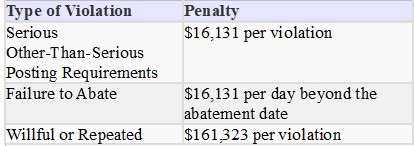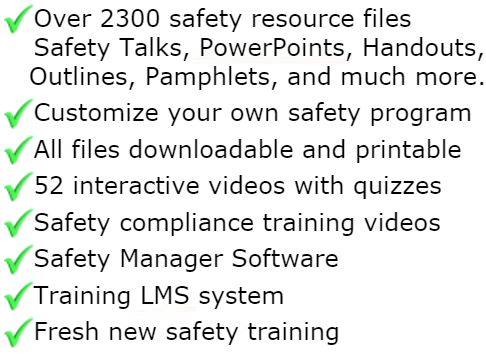
Workplace Violence Prevention
Violence in the workplace is a serious safety and health issue. Its most extreme form, homicide, is the fourth-leading cause of fatal occupational injury in the United States. Environmental conditions associated with workplace assaults have been identified and control strategies implemented in a number of work settings.
Workplace Violence Prevention Strategies
An average of 1.7 million people were victims of violent crime while working or on duty in the United States, according to a report published by the Bureau of Justice Statistics (BJS), each year from 1993 through 1999. An estimated 1.3 million (75%) of these incidents were simple assaults while an additional 19% were aggravated assaults. Of the occupations examined, police officers, corrections officers, and taxi drivers were victimized at the highest rates.
For the same time period, over 800 workplace homicides per year were recorded by the Bureau of Labor Statistics’ Census of Fatal Occupational Injuries.
Environmental Designs
Commonly implemented cash-handling policies in retail settings include procedures such as using locked drop safes, carrying small amounts of cash, and posting signs and printing notices that limited cash is available. It may also be useful to explore the feasibility of cashless transactions in taxicabs and retail settings through the use of machines that accommodate automatic teller account cards or debit cards. These approaches could be used in any setting where cash is currently exchanged between workers and customers.
Physical separation of workers from customers, clients, and the general public through the use of bullet-resistant barriers or enclosures has been proposed for retail settings such as gas stations and convenience stores, hospital emergency departments, and social service agency claims areas. The height and depth of counters (with or without bullet-resistant barriers) are also important considerations in protecting workers, since they introduce physical distance between workers and potential attackers. Consideration must nonetheless be given to the continued ease of conducting business; a safety device that increases frustration for workers or for customers, clients, or patients may be self-defeating.
Visibility and lighting are also important environmental design considerations. Making high-risk areas visible to more people and installing good external lighting should decrease the risk of workplace assaults.
Access to and egress from the workplace are also important areas to assess. The number of entrances and exits, the ease with which non-employees can gain access to work areas because doors are unlocked, and the number of areas where potential attackers can hide are issues that should be addressed. This issue has implications for the design of buildings and parking areas, landscaping, and the placement of garbage areas, outdoor refrigeration areas, and other storage facilities that workers must use during a work shift.
Numerous security devices may reduce the risk for assaults against workers and facilitate the identification and apprehension of perpetrators. These include closed-circuit cameras, alarms, two-way mirrors, card-key access systems, panic-bar doors locked from the outside only, and trouble lights or geographic locating devices in taxicabs and other mobile workplaces.
Personal protective equipment such as body armor has been used effectively by public safety personnel to mitigate the effects of workplace violence. For example, the lives of more than 1,800 police officers have been saved by Kevlar® vests.
Workplace Violence Administrative Controls
Staffing plans and work practices are important. Increasing the number of staff on duty may also be appropriate in any number of service and retail settings. The use of security guards or receptionists to screen persons entering the workplace and controlling access to actual work areas has also been suggested by security experts.
Work practices and staffing patterns during the opening and closing of establishments and during money drops and pickups should be carefully reviewed for the increased risk of assault they pose to workers. These practices include having workers take out garbage, dispose of grease, store food or other items in external storage areas, and transport or store money.
Policies and procedures for assessing and reporting threats allow employers to track and assess threats and violent incidents in the workplace. Such policies clearly indicate a zero tolerance of workplace violence and provide mechanisms by which incidents can be reported and handled. In addition, such information allows employers to assess whether prevention strategies are appropriate and effective. These policies should also include guidance on recognizing the potential for violence, methods for defusing or de-escalating potentially violent situations, and instruction about the use of security devices and protective equipment. Procedures for obtaining medical care and psychological support following violent incidents should also be addressed. Training and education efforts are clearly needed to accompany such policies.
Behavioral Strategies
Training employees in nonviolent response and conflict resolution has been suggested to reduce the risk that volatile situations will escalate to physical violence. Also critical is training that addresses hazards associated with specific tasks or worksites and relevant prevention strategies. Training should not be regarded as the sole prevention strategy but as a component in a comprehensive approach to reducing workplace violence. To increase vigilance and compliance with stated violence prevention policies, training should emphasize the appropriate use and maintenance of protective equipment, adherence to administrative controls, and increased knowledge and awareness of the risk of workplace violence.
Workplace Violence Facts
We have all read headlines about employees being attacked and injured in the workplace. With the increase in media coverage and some may argue, the desensitizing of the American public, workplace violence is projected to grow at a alarming rate. As your company grows, so does the potential for violent attacks in the workplace.
Did you know?
20 workers a week are murdered in the U.S?
An estimated 1 million workers (18,000 per week) are victims of nonfatal work place assaults each year.
The majority of workplace homicides are robbery-related crimes (71%).
Coworker and former workers are responsible for 9% of all workplace homicides.
76% of all workplace homicides are committed with a firearm.
The Majority of workplace homicides are believed to occur among people who do not know each other.
Although the experts disagree on how to completely prevent workplace violence, many agree on the steps that a company should take to reduce the frequency of assaults.
Preventing violence in the workplace
Establish a well-written employee handbook that outlines what a employee should do when they suspect possible workplace violence. This should include a system for anonymous notification including telephone, fax, email and person to person notification.
Train management on the recognizable signs of possible workplace violence.
Pre-screen applicants before hiring. Many times previous behavior in the workplace is a indicator of future problems.
Implement physical security guidelines that limit the exposure a worker may face. These include, Employee photo tags, on-site guards, coded keys,
Signs of potential workplace violence
Although no method to detect possible workplace violence exists, savvy managers and owners can detect warning signs that may prevent the unthinkable from happening
A rise in petty arguments with co-workers or supervisors.
Extreme changes in behavior.
Statements indicating desperation over family problems, financial problems or other personal problems up to contemplating suicide
Direct or veiled threats of harm. Inappropriate jokes
Intimidating, bullying or harassing behavior.
Bringing, brandishing or a fascination with fire-arms
Statements showing a fascination with media stories of workplace violence. Meetings that deteriorate into name calling sessions.
All materials in the members area for this topic index

GET INSTANT ACCESS
to THE MEMBERS LIBRARY
Safety materials created by safety professionals.
Access to the Safety Manager software.
Wide variety of safety videos and courses.
**Brand New** Safety Training Management System
Pre-Made Safety Materials Ready For Use
Created by experienced safety professionals & risk consultants. Saving you time, money, and risk of injuries.
95% of the work already done.
Below are the maximum penalty amounts, with the annual adjustment for inflation, that may be assessed after Jan. 15, 2024. (See OSHA Memo, Jan. 8, 2024).

**New OSHA HEAT 90 DAY**
>>Download Free HERE<<
**New 2024 OSHA 300 Form**
>>Download Free HERE<<
**Brand New**
Free with full membership subscription
Training LMS System
Ask The Safety Consultant
Safety Equipment Deal Finder

“SafetyInfo.com is the first go-to website for safety professionals and companies to use in establishing a solid safety program"
-Mike McKenzie, Certified Safety & Health Manager (CSHM), McSafety Solutions™
Note: You must have a full subscription to the Safety Library in order to use this material. Any use outside of your organization, for resell, or without an active membership is strictly prohibited and may result in prosecution under copyright infringement laws. Please contact us first, if you would be interested in reselling or using our materials for reproduction.
Inside the Members Library
Topic Index
Accident Prevention
Air Quality
Asbestos
Bloodborne Pathogens
Boilers
Chemical Safety
Compressed Gas
Confined Space
Construction
Construction Worksite
Cranes & Slings
Driver / Fleet Safety
Drug Free Workplace
Electrical
Emergency Management
Engineering Safety
Environmental
Equipment
Ergonomics
Fall Protection
Fire Safety & Prevention
First Aid
Flammable Materials
Forklifts
Hazard Communication
Hazardous Materials
Hearing Protection
Heat Stress
Hot Work
Housekeeping
Job Safety Analysis
Laboratory
Ladders
Lead
Lockout-Tagout
Machinery & Equipment
Material Handling
MSDS (SDS)
Medical & First Aid
Occupational Health
Office Safety
Off the Job Safety
Personal Protection
Process Safety
Record Keeping
Respiratory Protection
Silica Safety
Rules & Policies
Signs & Labels
Slips, Trips & Fall
Training
Terrorism Programs
Tool Safety
Vehicle & Driver
Violence Programs
Welding & Hot Work
Training Videos
Library Index
Training Materials
Videos/Courses
Talks
Articles
PowerPoint
Handouts
Training Overheads
Quizzes
Supervisor Briefs
Management Briefs
Safety Sessions
2 Minute OSHA Safety Talks
Pamphlets
First Aid Training
Supervisor Training
Hazardous Materials
Bomb Threat
Crossword Puzzles
Biological Agents
Forms & Documents
Forms
Checklists
Audit Guides
Inspections Guides
Signs & Labels
Environmental Audit Guides
Recordkeeping - OSHA 300
Sign & Label Maker
Safety Management Resources
Safety Manuals/Written Programs
Ergonomic Programs
Emergency Plans
Process Safety Management
Construction Safety
Occupational Health
Environmental
Topic Sheets
DOT Fleet-Driver
Hazardous Materials
Chemical Safety
Drug Free Workplace
Terrorism Programs
Development Guides
Safety Manager Software
Safety References & Graphics
Technical Safety Information
Posters
Topic & Fact Sheets
Development Information
Job Specific Safety Rules
Terrorism
Calculators
Safety Comic Strips
New Safety Training System
Schedule and train your employees with our materials. Add unlimited amount of employees. Record all progress and issue certificates. For group and individual training sessions.

